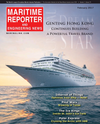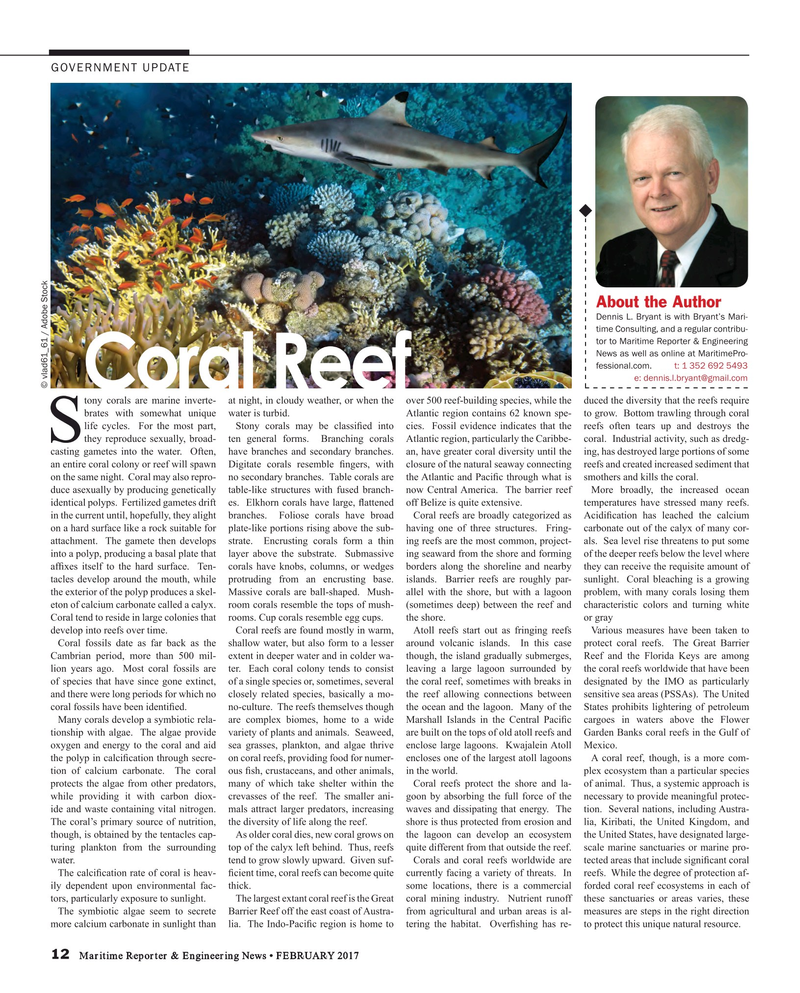
Page 12: of Maritime Reporter Magazine (February 2017)
The Cruise Industry Edition
Read this page in Pdf, Flash or Html5 edition of February 2017 Maritime Reporter Magazine
GOVERNMENT UPDATE
About the Author
Dennis L. Bryant is with Bryant’s Mari- time Consulting, and a regular contribu- tor to Maritime Reporter & Engineering
News as well as online at MaritimePro- fessional.com. t: 1 352 692 5493 e: [email protected] © vlad61_61 / Adobe Stock
Coral Reef tony corals are marine inverte- at night, in cloudy weather, or when the over 500 reef-building species, while the duced the diversity that the reefs require brates with somewhat unique water is turbid. Atlantic region contains 62 known spe- to grow. Bottom trawling through coral life cycles. For the most part, Stony corals may be classi? ed into cies. Fossil evidence indicates that the reefs often tears up and destroys the
Sthey reproduce sexually, broad- ten general forms. Branching corals Atlantic region, particularly the Caribbe- coral. Industrial activity, such as dredg- casting gametes into the water. Often, have branches and secondary branches. an, have greater coral diversity until the ing, has destroyed large portions of some an entire coral colony or reef will spawn Digitate corals resemble ? ngers, with closure of the natural seaway connecting reefs and created increased sediment that on the same night. Coral may also repro- no secondary branches. Table corals are the Atlantic and Paci? c through what is smothers and kills the coral.
duce asexually by producing genetically table-like structures with fused branch- now Central America. The barrier reef More broadly, the increased ocean identical polyps. Fertilized gametes drift es. Elkhorn corals have large, ? attened off Belize is quite extensive. temperatures have stressed many reefs. in the current until, hopefully, they alight branches. Foliose corals have broad Coral reefs are broadly categorized as Acidi? cation has leached the calcium on a hard surface like a rock suitable for plate-like portions rising above the sub- having one of three structures. Fring- carbonate out of the calyx of many cor- attachment. The gamete then develops strate. Encrusting corals form a thin ing reefs are the most common, project- als. Sea level rise threatens to put some into a polyp, producing a basal plate that layer above the substrate. Submassive ing seaward from the shore and forming of the deeper reefs below the level where af? xes itself to the hard surface. Ten- corals have knobs, columns, or wedges borders along the shoreline and nearby they can receive the requisite amount of tacles develop around the mouth, while protruding from an encrusting base. islands. Barrier reefs are roughly par- sunlight. Coral bleaching is a growing the exterior of the polyp produces a skel- Massive corals are ball-shaped. Mush- allel with the shore, but with a lagoon problem, with many corals losing them eton of calcium carbonate called a calyx. room corals resemble the tops of mush- (sometimes deep) between the reef and characteristic colors and turning white
Coral tend to reside in large colonies that rooms. Cup corals resemble egg cups. the shore. or gray develop into reefs over time. Coral reefs are found mostly in warm, Atoll reefs start out as fringing reefs Various measures have been taken to
Coral fossils date as far back as the shallow water, but also form to a lesser around volcanic islands. In this case protect coral reefs. The Great Barrier
Cambrian period, more than 500 mil- extent in deeper water and in colder wa- though, the island gradually submerges, Reef and the Florida Keys are among lion years ago. Most coral fossils are ter. Each coral colony tends to consist leaving a large lagoon surrounded by the coral reefs worldwide that have been of species that have since gone extinct, of a single species or, sometimes, several the coral reef, sometimes with breaks in designated by the IMO as particularly and there were long periods for which no closely related species, basically a mo- the reef allowing connections between sensitive sea areas (PSSAs). The United coral fossils have been identi? ed. no-culture. The reefs themselves though the ocean and the lagoon. Many of the States prohibits lightering of petroleum
Many corals develop a symbiotic rela- are complex biomes, home to a wide Marshall Islands in the Central Paci? c cargoes in waters above the Flower tionship with algae. The algae provide variety of plants and animals. Seaweed, are built on the tops of old atoll reefs and Garden Banks coral reefs in the Gulf of oxygen and energy to the coral and aid sea grasses, plankton, and algae thrive enclose large lagoons. Kwajalein Atoll Mexico. the polyp in calci? cation through secre- on coral reefs, providing food for numer- encloses one of the largest atoll lagoons A coral reef, though, is a more com- tion of calcium carbonate. The coral ous ? sh, crustaceans, and other animals, in the world. plex ecosystem than a particular species protects the algae from other predators, many of which take shelter within the Coral reefs protect the shore and la- of animal. Thus, a systemic approach is while providing it with carbon diox- crevasses of the reef. The smaller ani- goon by absorbing the full force of the necessary to provide meaningful protec- ide and waste containing vital nitrogen. mals attract larger predators, increasing waves and dissipating that energy. The tion. Several nations, including Austra-
The coral’s primary source of nutrition, the diversity of life along the reef. shore is thus protected from erosion and lia, Kiribati, the United Kingdom, and though, is obtained by the tentacles cap- As older coral dies, new coral grows on the lagoon can develop an ecosystem the United States, have designated large- turing plankton from the surrounding top of the calyx left behind. Thus, reefs quite different from that outside the reef. scale marine sanctuaries or marine pro- water. tend to grow slowly upward. Given suf- Corals and coral reefs worldwide are tected areas that include signi? cant coral
The calci? cation rate of coral is heav- ? cient time, coral reefs can become quite currently facing a variety of threats. In reefs. While the degree of protection af- ily dependent upon environmental fac- thick. some locations, there is a commercial forded coral reef ecosystems in each of tors, particularly exposure to sunlight. The largest extant coral reef is the Great coral mining industry. Nutrient runoff these sanctuaries or areas varies, these
The symbiotic algae seem to secrete Barrier Reef off the east coast of Austra- from agricultural and urban areas is al- measures are steps in the right direction more calcium carbonate in sunlight than lia. The Indo-Paci? c region is home to tering the habitat. Over? shing has re- to protect this unique natural resource.
12 Maritime Reporter & Engineering News • FEBRUARY 2017
MR #2 (10-17).indd 12 MR #2 (10-17).indd 12 2/6/2017 9:44:46 AM2/6/2017 9:44:46 AM

 11
11

 13
13
